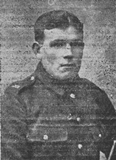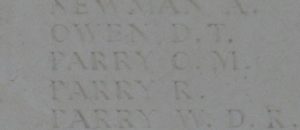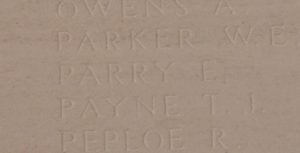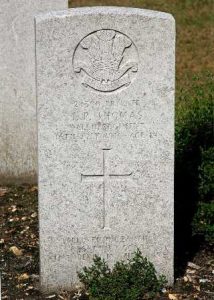Upper Chapel is a small village situated on the B4520 road between Brecon and Builth Wells, in the historic county of Breconshire. The village lies to the south of the Army’s Sennybridge Training Area. Just three miles south of Upper Chapel is its sister settlement, Lower Chapel. Situated within Upper Chapel, or Duffryn Honddu, Churchyard is the village war memorial, which commemorates the local men who died, and those who returned home safely, during the Great War. There is also one grave in the Churchyard of a local soldier who fell during the Second World War.
The Great War, 1914-1918
Driver E. Clayton. This man cannot presently be identified.
David Jones, Private, 12970, South Wales Borderers. David was the son of Hugh Jones and Margaret Jones (nee Bevan), of Tyncanol, Upper Chapel. He had lived with Daniel Williams of Pantycwrt and worked at the International Colliery at Abercrave for three years prior to enlisting at Brecon into the 4th Battalion, South Wales Borderers in September 1914. The battalion was attached to 40 Brigade, 13th (Western) Division, and on 29 June 1915 sailed from Avonmouth for Mudros, preparatory for landing on Gallipoli on 15 July 1915, relieving the 29th Division. They left and returned to Mudros at the end of the month, and the entire Division landed at ANZAC Cove between 3 and 5 August 1915, taking part in the Battle of Sari Bair, and in further actions at Russell’s Top, and Hill 60, ANZAC. David was killed in action at ANZAC on 22 August 1915, aged 26. He is buried in grave I. C. 23. in Green Hill Cemetery, Gallipoli. His cousin, Rees Morgan Jones (below), also fell at Gallipoli.

Rees Morgan Jones, Private, 3341, Welsh Regiment. Rees, known as Morgan, was the son of Ebenezer Jones and Mary Jones (nee Bevan), of Rhydberry, Merthyr Cynog. He worked as a waggoner at Rhos Farm, Talgarth prior to the war. Morgan enlisted into the 1/5th Battalion, Welsh Regiment soon after the outbreak of war. The battalion was the local Territorial unit and mobilised for war at Pontypridd in August 1914, as part of South Wales Brigade, Welsh Division and moved to Tunbridge Wells until the end of the month, before moving to Scotland to man the Forth and Tay Defences. On 17 April 1915 the battalion moved to Bedford, joining 158 Brigade, 53rd (Welsh) Division. On 19 July 1915 the entire Division sailed from Devonport for Imbros and on 9 August 1915 landed at Suvla Bay. The infantry moved off the beaches across the Salt Lake, under shellfire, into the scrub covered Chocolate Hill, but due to a lack of maps and no knowledge of the terrain, many of the units became disorientated, and the situation became chaotic. Morgan was badly wounded during the landings and was evacuated aboard a Hospital Ship waiting offshore. He died of his wounds at sea on 11 August 1915, aged 23. Morgan was buried at sea, so is commemorated on the Helles Memorial, Gallipoli. Morgan is not commemorated on the Upper Chapel War Memorial. His cousin, David Jones (above), also fell at Gallipoli.
David Phillips, Private, 19903, South Wales Borderers. David was born at Upper Chapel, Breconshire, the son of Thomas Phillips and Sarah Phillips (nee Jones). He worked as a waggoner prior to the war. His father had died when he was young, and in 1913 his mother married John Oliver, a shepherd, of Gammallt, Rhayader. David enlisted at Newport into the 3rd Battalion, South Wales Borderers soon after the outbreak of war, and on 20 September 1915 embarked for Gallipoli, joining the 2nd Battalion, South Wales Borderers, which was attached to 87 Brigade, 29th Division. The Division had been on the Peninsula since the landings of 25 April, and remained there until evacuation to Egypt on 11 January 1916, before being transferred to the Western Front on 15 March 1916. The Division took over a section of front line near Beaumont Hamel, facing the German strongpoint of Y-Ravine, and its infantry battalions soon began the usual routine of trench rotation over the coming weeks. On 3 April 1916 the 2nd SWB moved into the Somme trenches for the first time and on the following day suffered a heavy bombardment by German trench mortars. The battalion sent out patrols on 5 April, to examine the wire in front, suffering two men missing. The battalion then came under heavy shellfire again during the afternoon. Another patrol was sent out on 6 April, to attempt to locate the missing men, but was unsuccessful, and when returning, the Germans opened another heavy barrage onto the line held by the 2nd SWB before launching a large-scale trench raid at around 22.30. Heavy fighting raged throughout the night, while the Germans managed to withdraw, taking several prisoners with them. David had been wounded during the fighting that night, and died of his wounds on 7 April 1916, aged 23. He is buried in Gézaincourt Communal Cemetery Extension, France.
Charles Morgan Parry, Private, 27398, South Wales Borderers. Charles was the son of Evan and Mary Parry, of Ffynoncer, Merthyr Cynog. He worked as a blacksmith prior to the war. Charles enlisted into the South Wales Borderers at Brecon, together with his brother Evan, in the Spring of 1915. The two brothers were drafted to France in the summer of 1916, joining the 2nd Battalion, South Wales Borderers, which was attached to 87 Brigade, 29th Division. The Division had suffered terrible casualties during the opening assault of the Somme offensive at Y-Ravine on 1 July 1916 and was then pulled out of the line to rest and rebuild before moving back into the line and taking part in the latter stages of the Somme offensive. In the Spring of 1917 the Division fought at the Battle of the Scarpe, which was part of the Arras Offensive, seeing heavy fighting around Monchy-le-Preux, and then moved further north to Ypres, initially to hold the line whilst other units had been withdrawn for specialist training, in readiness for the Third Battle of Ypres, which opened on 31 July 1917. The 29th Division went into reserve whilst the first attacks, the Battle of Pilckem Ridge, took place, then on the night of 14-15 August the 2nd SWB moved into the line facing Langemarck, ready to launch another offensive. On the following day the battalion reconnoitred the ground in front of them, and laid white tapes in No Man’s Land, to guide the attacking troops, and at dawn on 16 August 1917 the 2nd SWB launched an attack on Langemarck. The battalion successfully took its two objectives, but had suffered 163 casualties. The Division then had another period out of the line to rest and refit before taking part in further fighting near Poelcapelle. Early in October 1917 the Division was relieved from the line at Ypres, and moved south to the Bellacourt area, to prepare to take part in the forthcoming Battle of Cambrai. The Division entrained for Péronne on 17 November, marching to a camp four miles out of the town at Haut Allaines, then by midnight on 18 November had reached Fins. On the following day the Division received its battle stores and detailed orders for the forthcoming battle, marching off via Gouzeaucourt to its assembly positions at Marcoing. The assault began at dawn on 20 November, but the Division suffered terrible casualties whilst attacking Masnières, on the Hindenburg Line. The Division wintered near Masnières and moved back to Flanders in the beginning of January 1918, taking over the Bellevue sector. The German Spring Offensive hit the British on the Somme on 21 March 1918, and hit in Flanders just weeks later. The 29th Division was holding the line at Passchendaele when the Germans launched their offensive on the Lys on 9 April and was relieved before being moved to Outtersteene, taking up defensive positions at Les Haies Basses. At dawn on 11 April 1918 the Germans hit the Division in overwhelming force and heavy fighting raged throughout the day in a desperate defensive action. Charles was killed in action during the day. The 24-year-old has no known grave and is commemorated on the Ploegsteert Memorial, Belgium. His brother, Evan Parry (below), had been killed at Arras in 1917.

Evan Parry, Private, 27391, South Wales Borderers. Evan was the son of Evan and Mary Parry, of Ffynonoer, Merthyr Cynog. He worked as a stonemason prior to the war. Evan enlisted into the South Wales Borderers at Brecon, together with his brother Charles, in the Spring of 1915. The two brothers were drafted to France in the summer of 1916, joining the 2nd Battalion, South Wales Borderers, which was attached to 87 Brigade, 29th Division. The Division had suffered terrible casualties during the opening assault of the Somme offensive at Y-Ravine on 1 July 1916 and was then pulled out of the line to rest and rebuild before moving back into the line and taking part in the latter stages of the Somme offensive. In the Spring of 1917 the Division fought at the Battle of the Scarpe, which was part of the Arras Offensive, seeing heavy fighting around Monchy-le-Preux. The Division returned to Arras to rest and rebuild, with the 2nd SWB moving to Duisans where several drafts of reinforcements arrived and the men were put through some routine training regimes. On 14 May the battalion moved back into the line at Monchy-Le-Preux, taking over a section of trenches between Snaffle Trench, Orchard Trench and East Trench, in readiness to take part in another assault. Evan was killed by German artillery fire whilst the battalion was in the line here on the evening of 18 May 1917. The 30-year-old has no known grave and is commemorated on the Arras Memorial, France. His brother, Charles Morgan Parry (above), was killed near Outtersteene in 1918.

Edward James Thomas, Private, 29547, South Wales Borderers. Edward was the son of Edward and Margaret Thomas, of Tydu, Upper Chapel. He married Eunice Harding in 1915 and the couple had two sons, William, born out of wedlock in 1914, and Edward, born 1916. Edward had enlisted into the South Wales Borderers at Brecon and was drafted to France in the winter of 1916-17, joining the 5th Battalion, South Wales Borderers, which was the Pioneer Battalion to the 19th (Western) Division. Edward probably joined the battalion at Bernaville, where it was rebuilding following losses during the latter stages of the Somme offensive. The Division wintered on the Somme and in February followed the German withdrawal to the Hindenburg Line. During the middle of March 1917, the Division was relieved from the line and began to move north, taking over positions in the Ypres Salient, and on 7 June took part in the assault on Messines Ridge, which was famously preceded by the blowing of a series of 19 huge underground mines. The 19th Division saw heavy fighting during the battle, then enjoyed a short spell in reserve, but the 5th SWB was kept hard at work, improving trenches, and repairing roads and tramways over the following weeks. The Third Battle of Ypres, or Passchendaele, was launched on 31 July 1917, with an assault upon the Pilckem Ridge. The 5th SWB were hard at work while the assault was in progress, repairing trenches and roads under heavy artillery fire. Edward was killed in action by shellfire during the day. The body of the 21-year-old was not recovered off the battlefield for almost a month due to incessant shellfire and he was buried in New Irish Farm Cemetery, Belgium.
John Philip Thomas, Private, 24300, Welsh Regiment. John was the son of Thomas and Elizabeth Thomas, of Tynwain Cottage, Upper Chapel. His father died when John was just two years old and John went to live with his grandparents, Mathew, and Mary Phillips, at St. Harmon. By 1911 he was living with his aunt, Annie Phillips, who had fostered him, at 4, South Street, Bargoed. John enlisted into the 16th Battalion, Welsh Regiment at Bargoed early in 1915. The battalion had been raised in Cardiff and formed in Porthcawl, before moving to Colwyn Bay in December 1914 to join 130 Brigade, 43rd (Welsh) Division. On 29 April 1915 the formation became renumbered 115 Brigade, 38th (Welsh) Division, before moving to Winchester to complete its training. The Division moved to France on 2 December 1915 and moved to the Nursery Sector near Fleurbaix for trench initiation alongside the Guards Division. The Division then held a sector of the line near Cuinchy before marching south to the Somme sector in June 1916 to take part in the assault on Mametz Wood. The first attack on the wood was launched on a two-battalion front on 7 July, but failed, and the Divisional Commander, Sir Ivor Philipps, was replaced before the Division attacked again on a two Brigade front on 10 July 1916. After two days of ferocious hand-to-hand fighting, the wood was cleared up to its northern edge, before the battered Division was relieved. John had been wounded during the fighting for the wood and was evacuated to hospital at Rouen. He died of his wounds there on 16 July 1916, aged 19. John is buried in St. Sever Cemetery, Rouen, France. He is not commemorated on the Upper Chapel War memorial.

Hugh Williams, Gunner, 881445, Royal Field Artillery. Hugh was the son of William Williams and Catherine Williams, of Upper Chapel. He had moved to Ystradgynlais prior to the war and in 1916 married Catherine Jane Williams, of Gwaunton, Ystradgynlais. Hugh enlisted at Gurnos into the Royal Field Artillery and was posted to France soon after his marriage, joining D Battery, 317th Brigade, Royal Field Artillery, which was attached to the 63rd (Royal Naval) Division. The Division had moved to France from Egypt in May 1916, following service at Gallipoli and saw its first major action during the Battle of the Ancre. In April 1917 the Division was at Arras, and fought at the Second Battle of the Scarpe, where it captured Gavrelle. The Division then fought at the Battle of Arleux, before moving north to Ypres, where it took part in the Second Battle of Passchendaele. Its next major action was at Cambrai, during the Action of Welch Ridge, and the Division was still in the area when the Germans launched their Spring Offensive on 21 March 1918. From 21 August, the Division took part in the Battle of Albert, which marked the beginning of the great offensive which was to end the war. The Divisional artillery opened its barrage from positions at Ablainzeville and as the Division began to advance, the guns followed. By 13 September the Division had advanced as far as Havrincourt and the artillery set up around Havrincourt Wood. The artillery came under heavy fire here from German artillery on 18 September and suffered ten casualties. Hugh was among three officers and seven other ranks wounded during the day. He was evacuated to the 19th Casualty Clearing Station, where he died of his wounds on 26 September 1918. The 22-year-old is buried in Sunken Road Cemetery, Boisleux-St. Marc, France. Hugh is not commemorated on the Upper Chapel war memorial.
World War Two, 1939-1945
Frank Dilwyn Raymond Powell, Guardsman, 2737714, Welsh Guards. Frank was the son of Thomas Powell, and Margaret Emily Powell, of The Gorof, Upper Chapel. He enlisted into the Welsh Guards soon after the outbreak of war and was posted to the Depot at Caterham for training. Frank died at Caterham on 11 September 1940. The body of the 19-year-old was brought back home and he was buried in Upper Chapel Churchyard. Interestingly, the inscription at the base of his headstone reads: ‘GREATER LOVE HATH NO MAN THAN THIS, THAT A MAN LAY DOWN HIS LIFE FOR HIS FRIENDS’.
ALSO OF THE MEN WHO SERVED IN THE GREAT WAR
Serg. A. Parry
Cpl. A. Evans
Cpl. H.C. Phillips
Bdn. W.J: Probert
Dvr. D.R. Williams
Pte W.T. Williams
Pte. T. Jones
Pte. H. Jones
Pte. M.R. Jones
Pte. E.H. Phillips
Gunr. F.T. Philips
Gunr. A. Mold
Rfn. H.C. Parry
Rfn. A.S. Parry
Pte. R. Thomas
Pte. D. Davies
Pte. D. Evans
Pte. W. Pugh
Pte. D.P. Parry
Pte. W.P. Parry